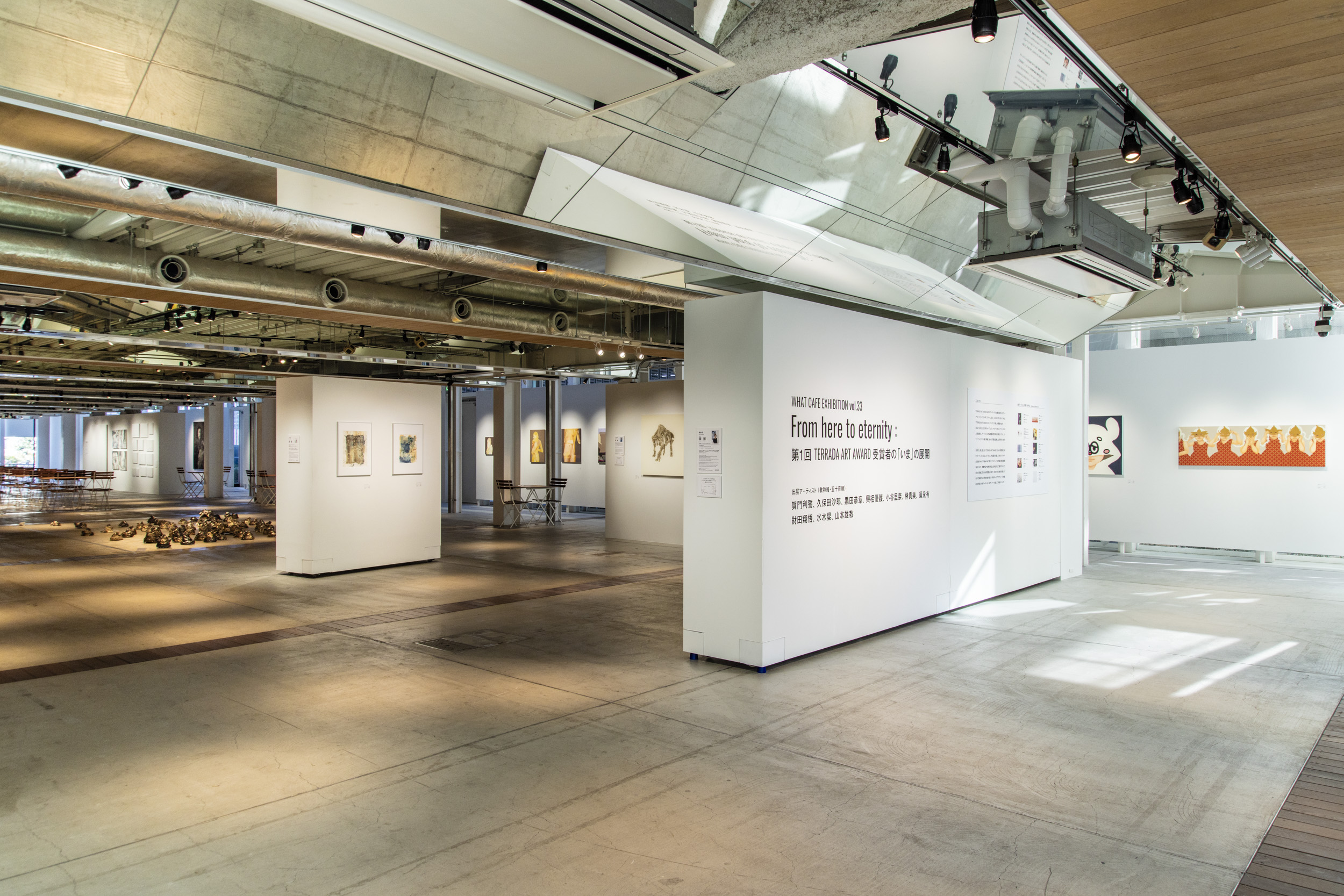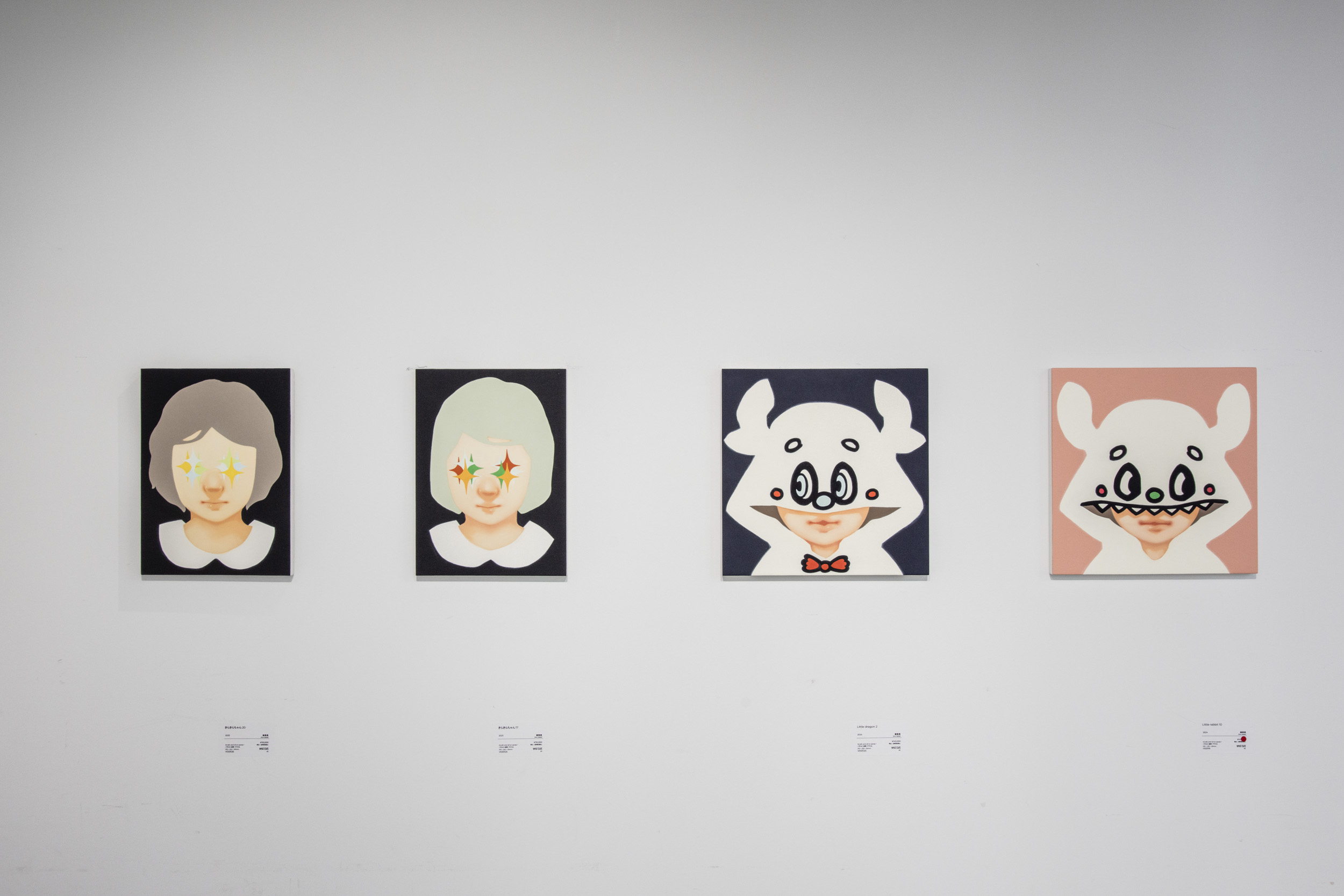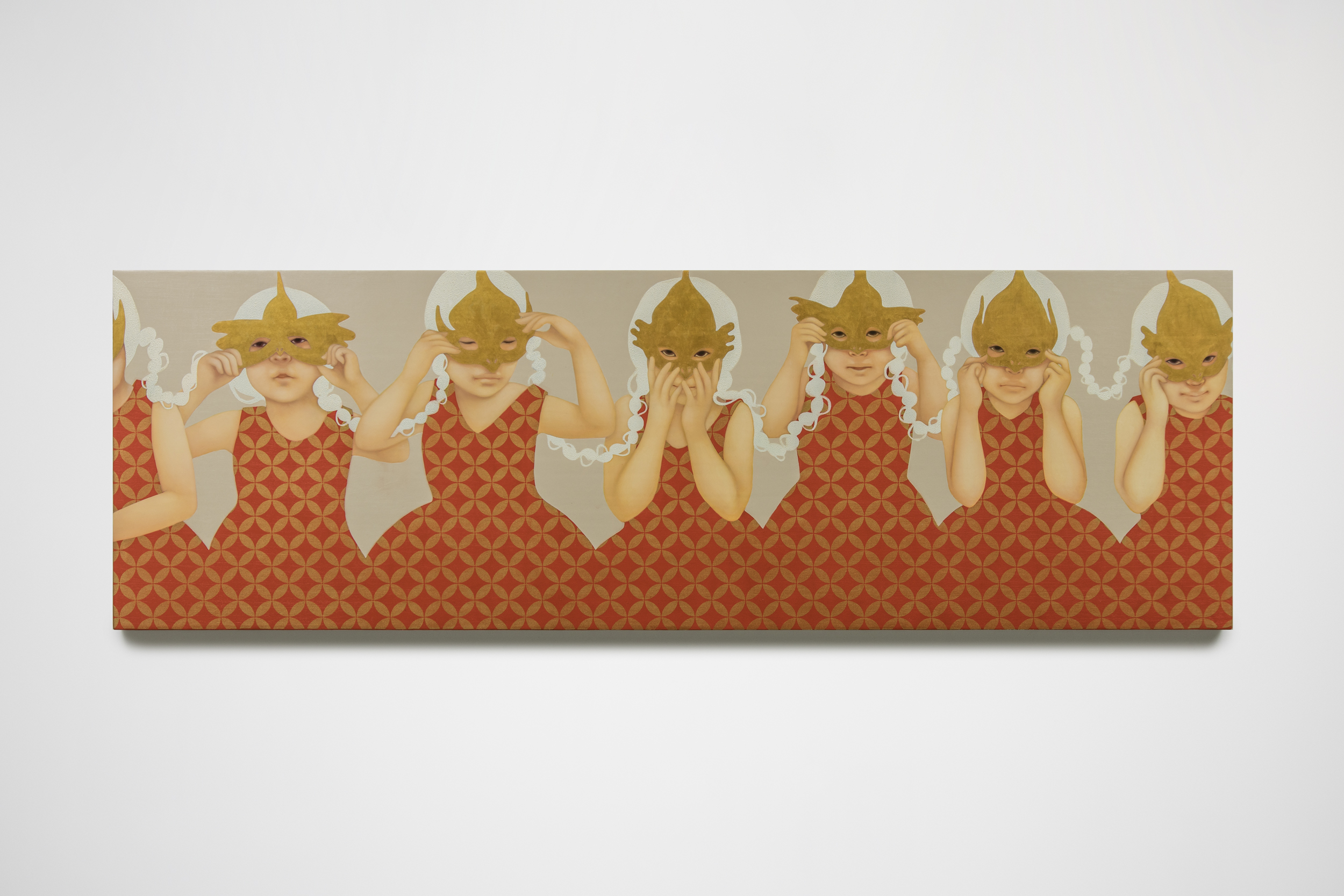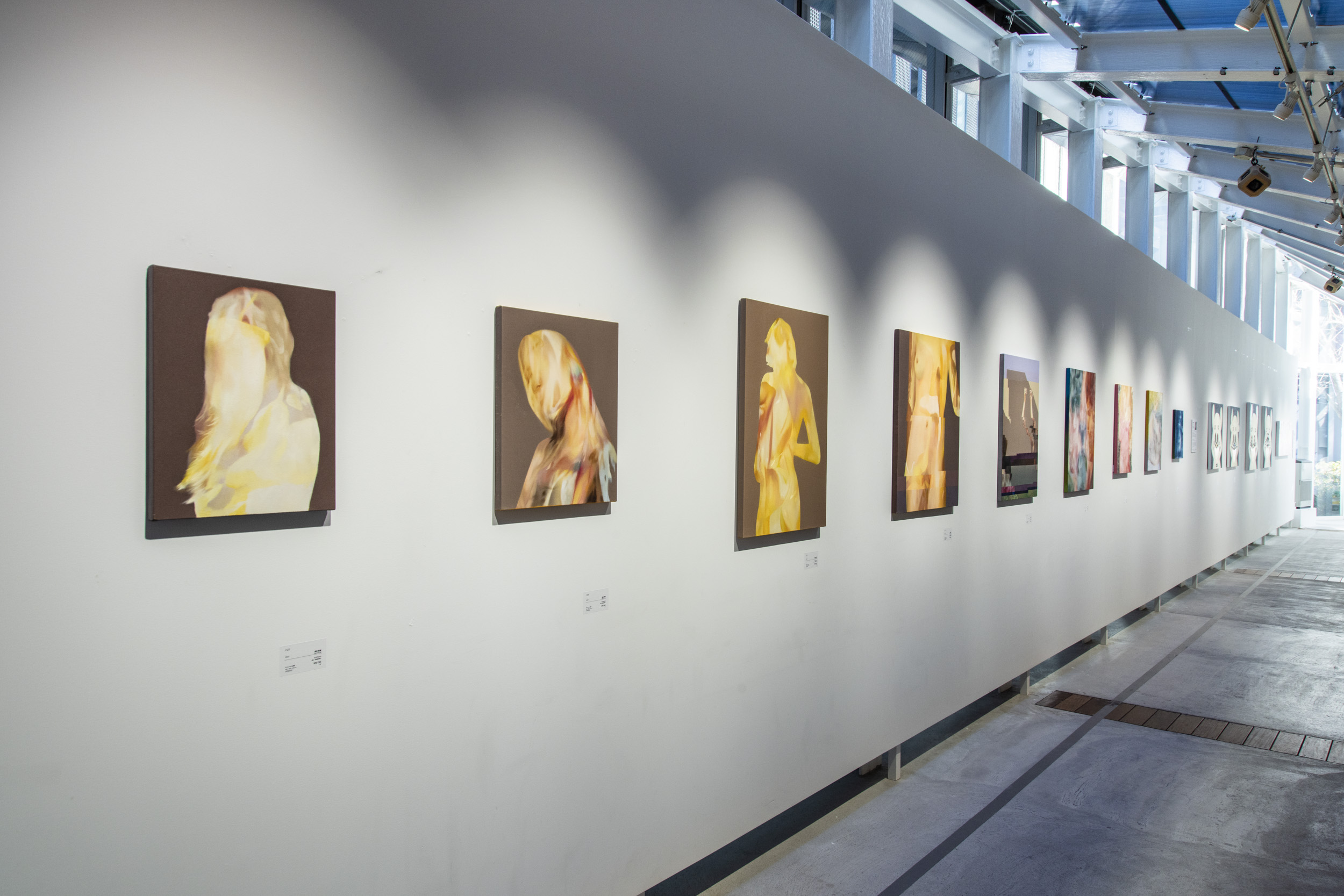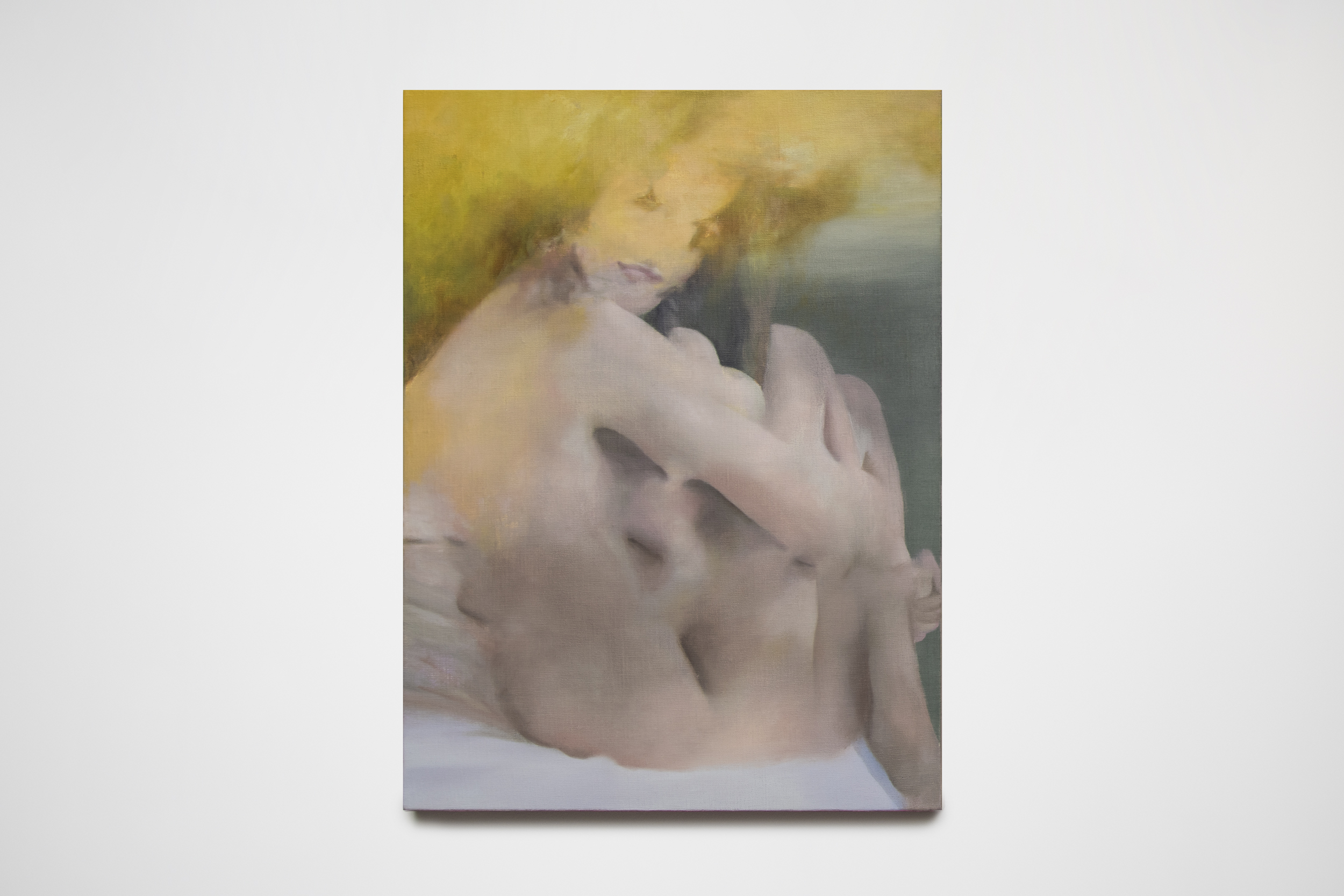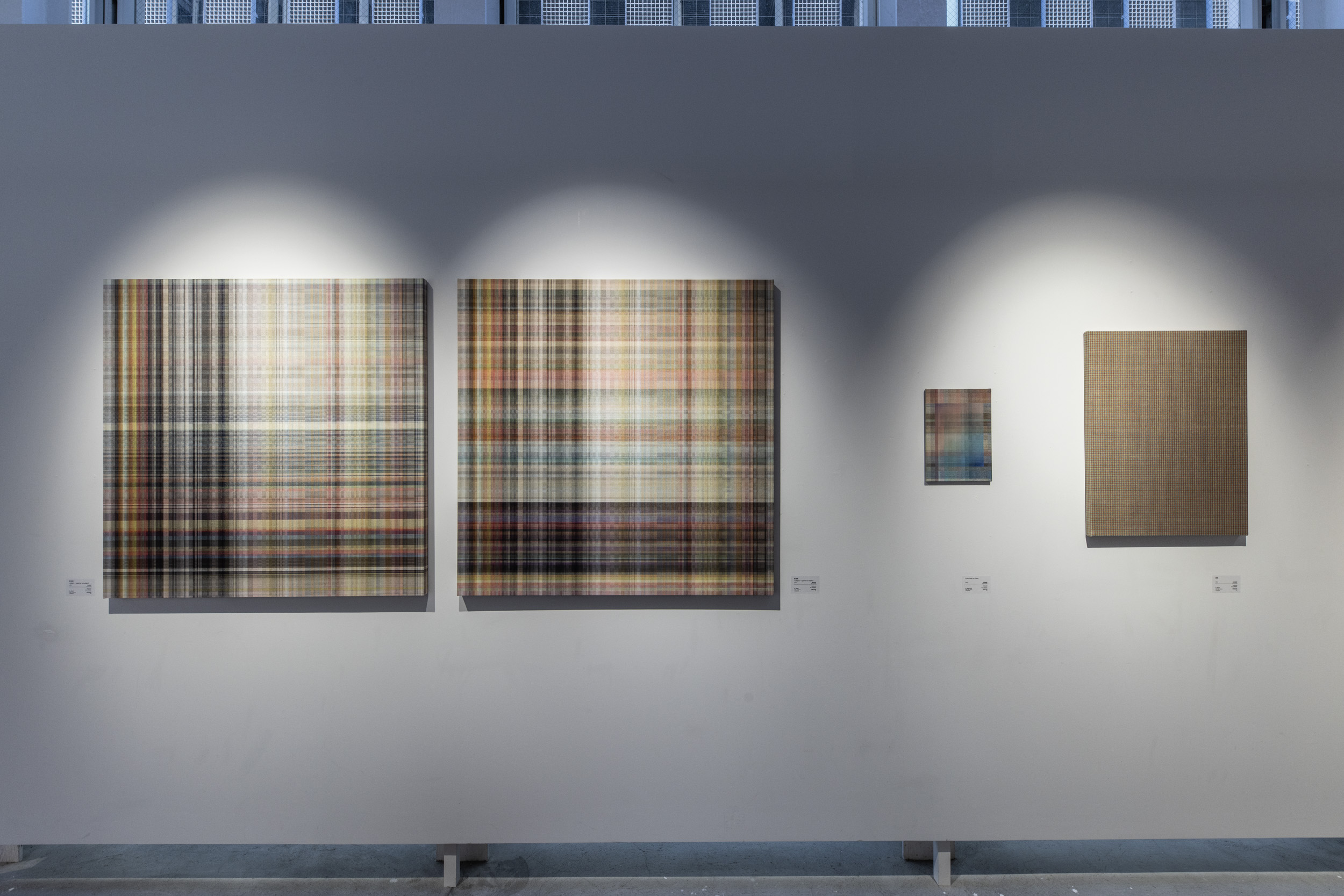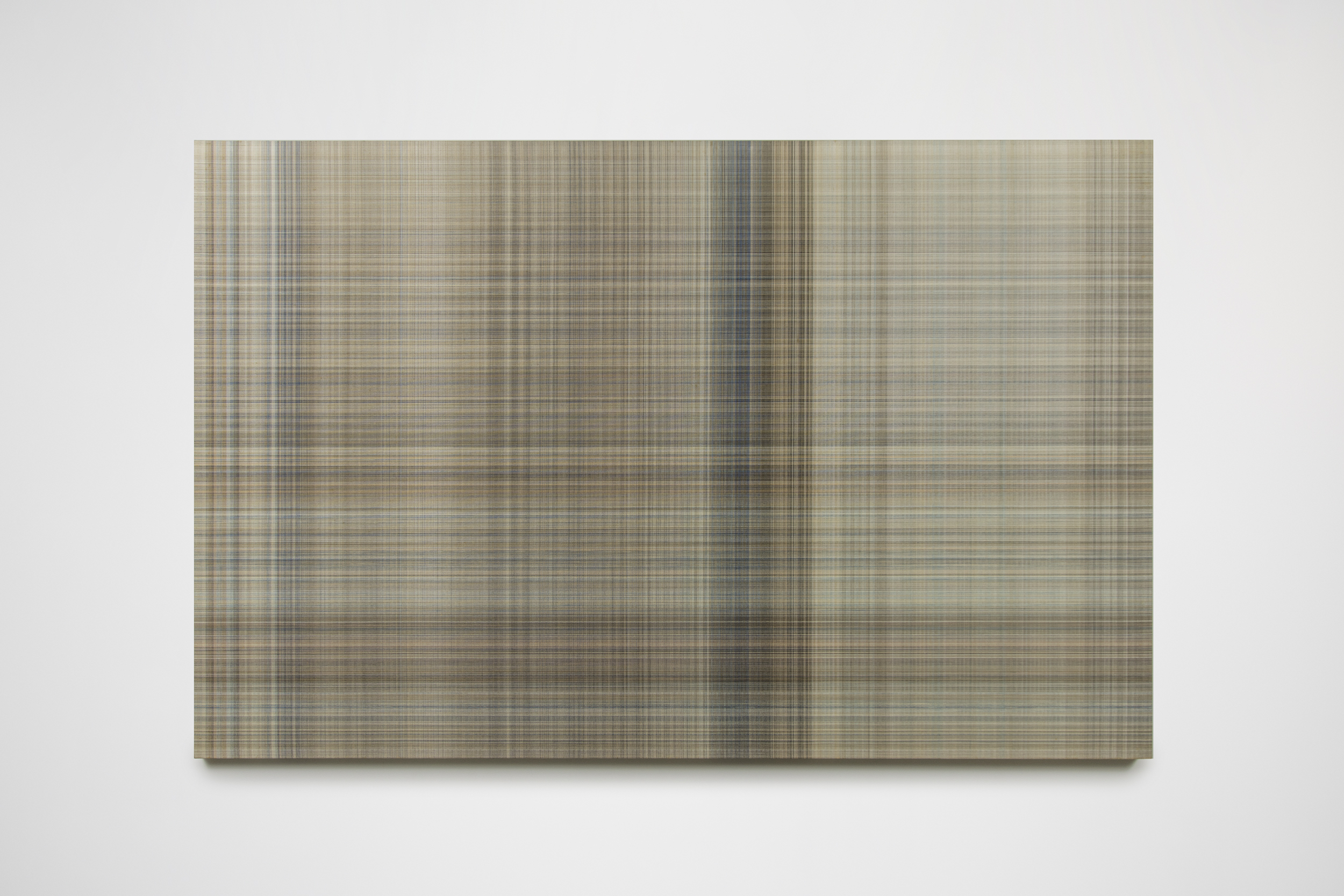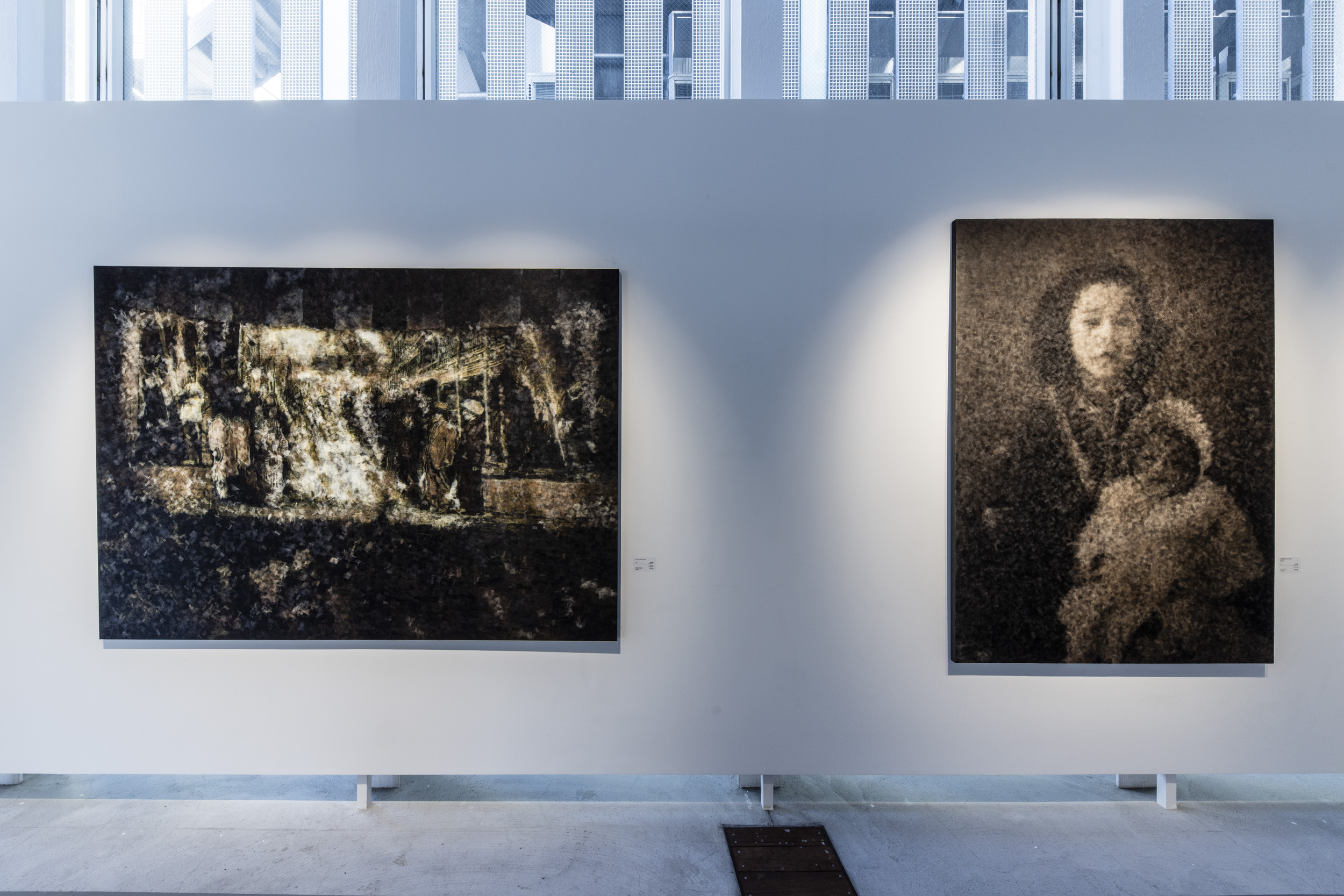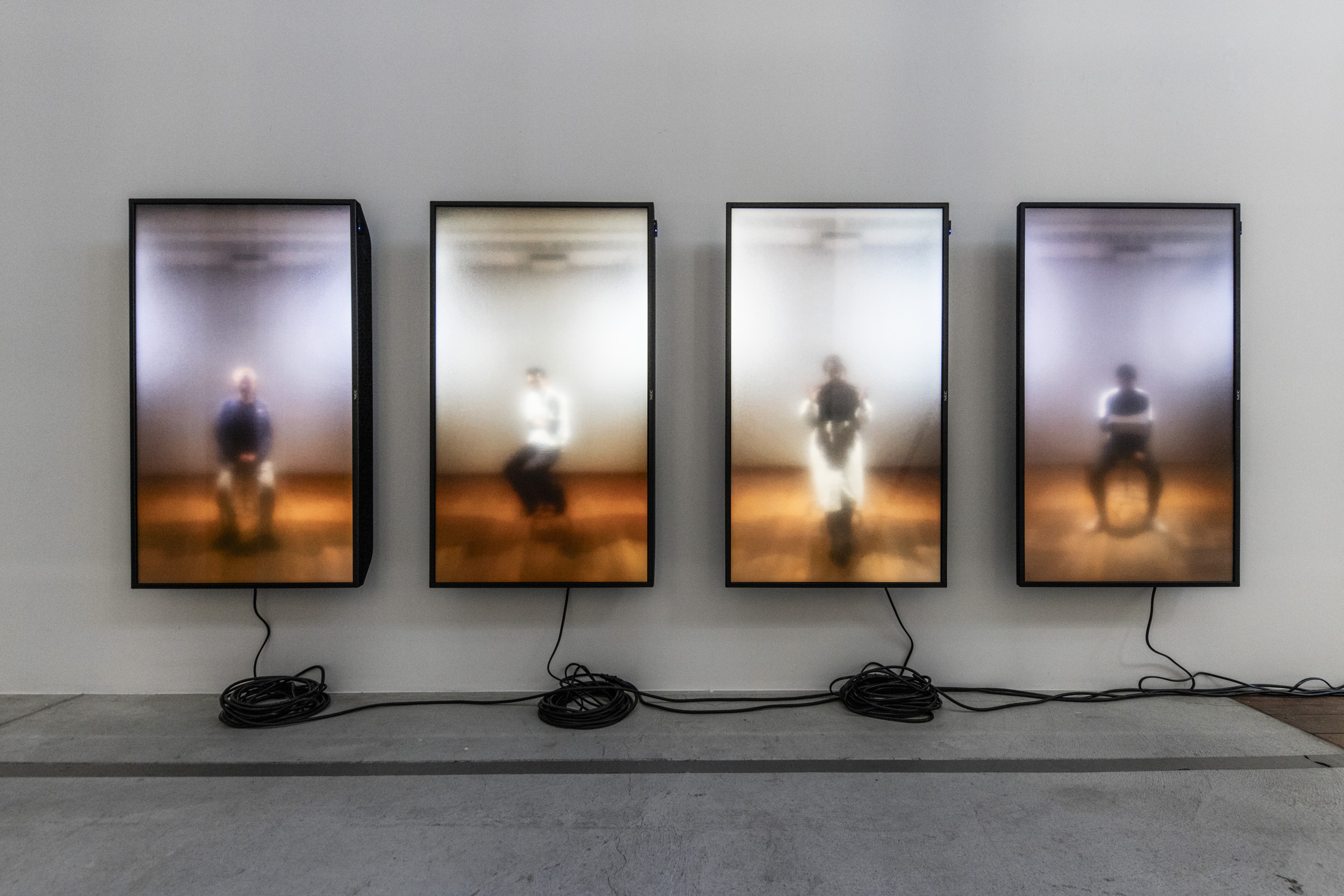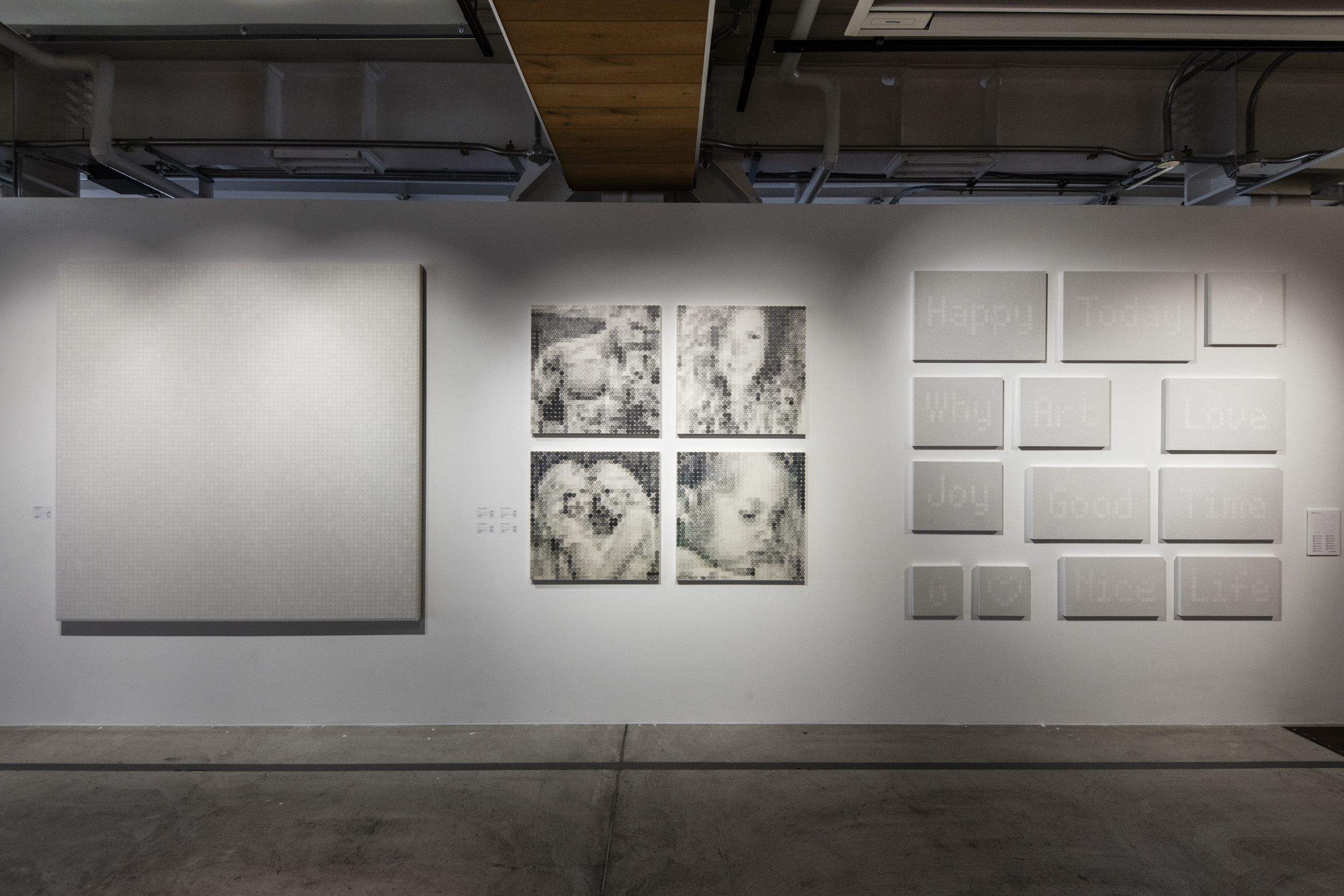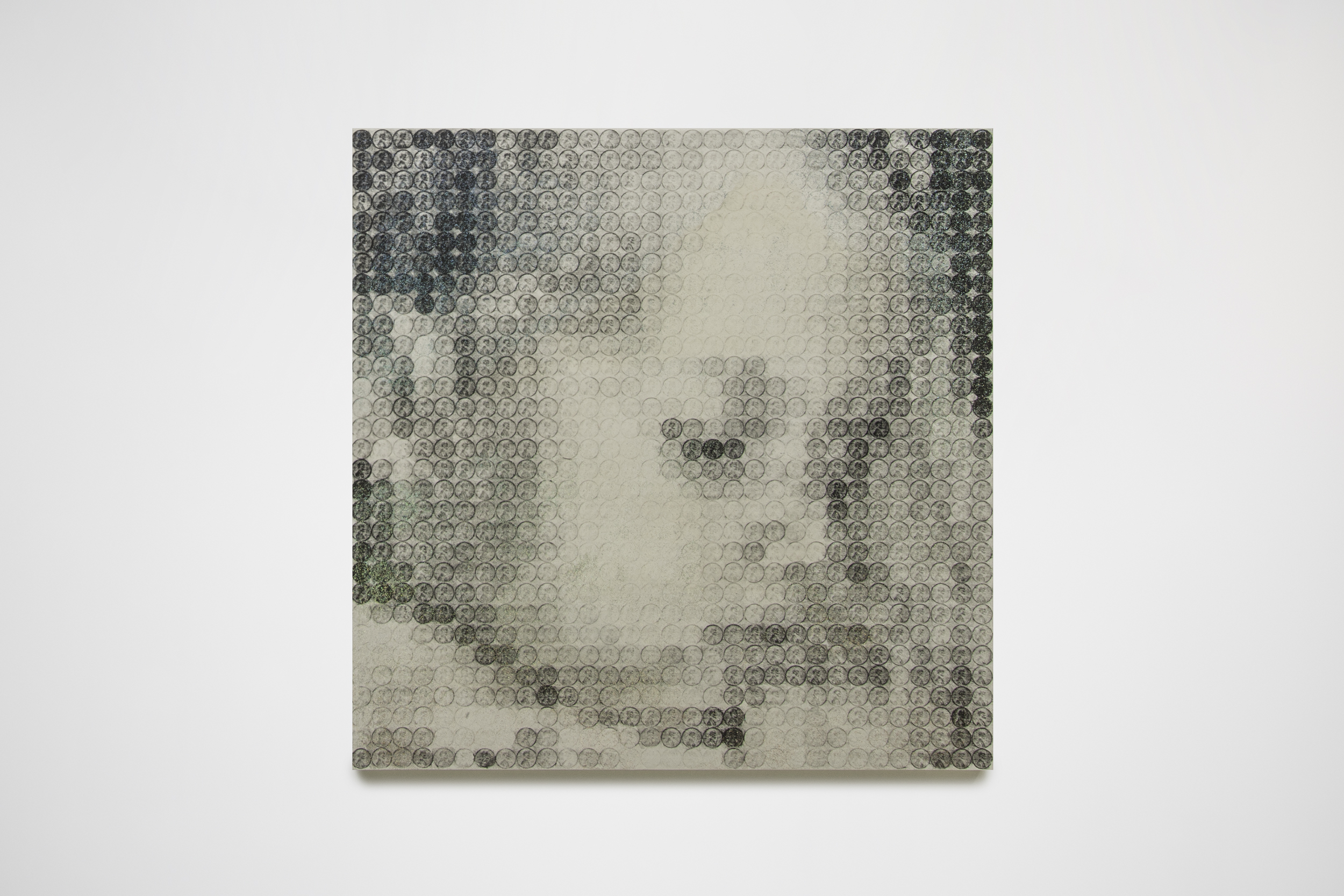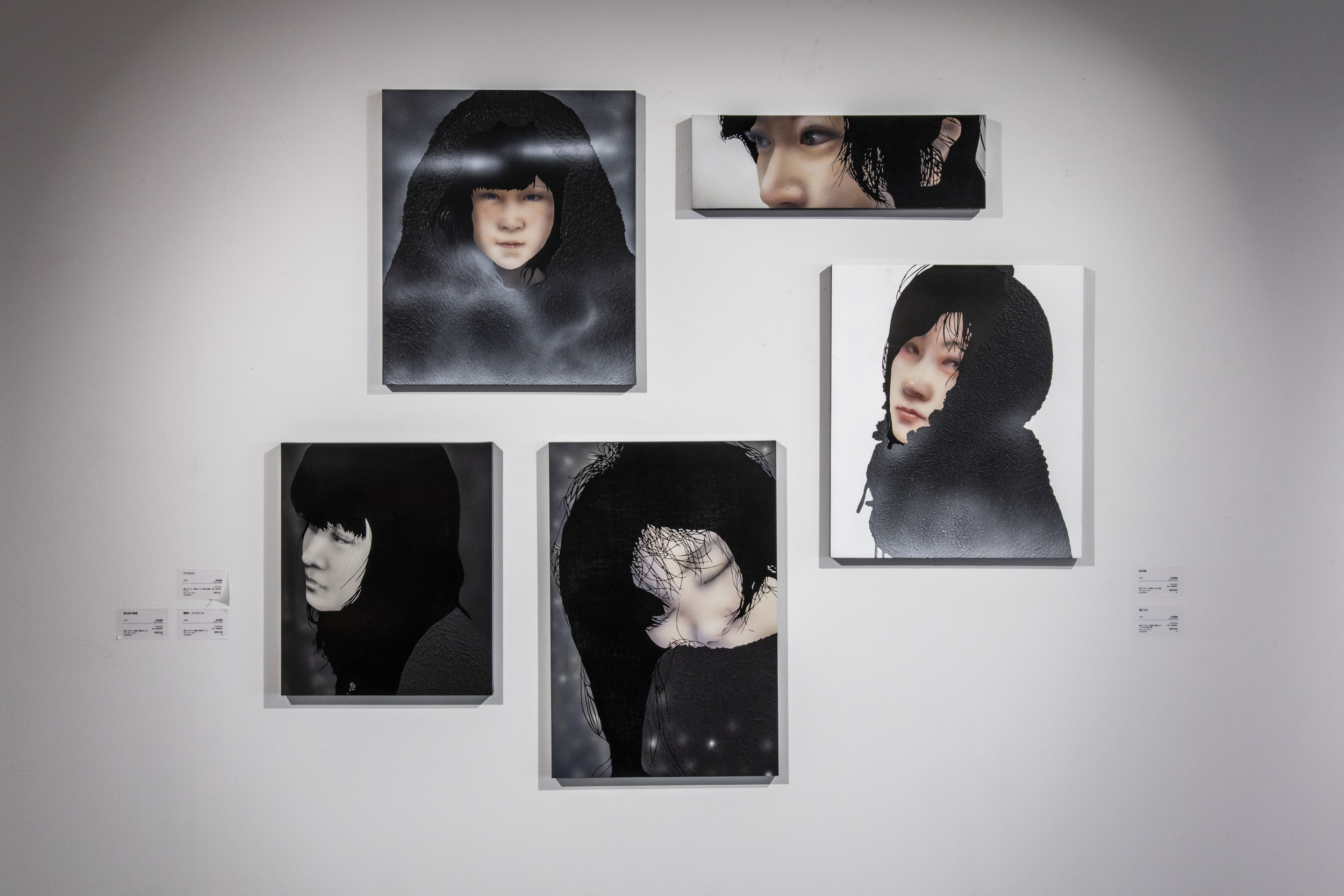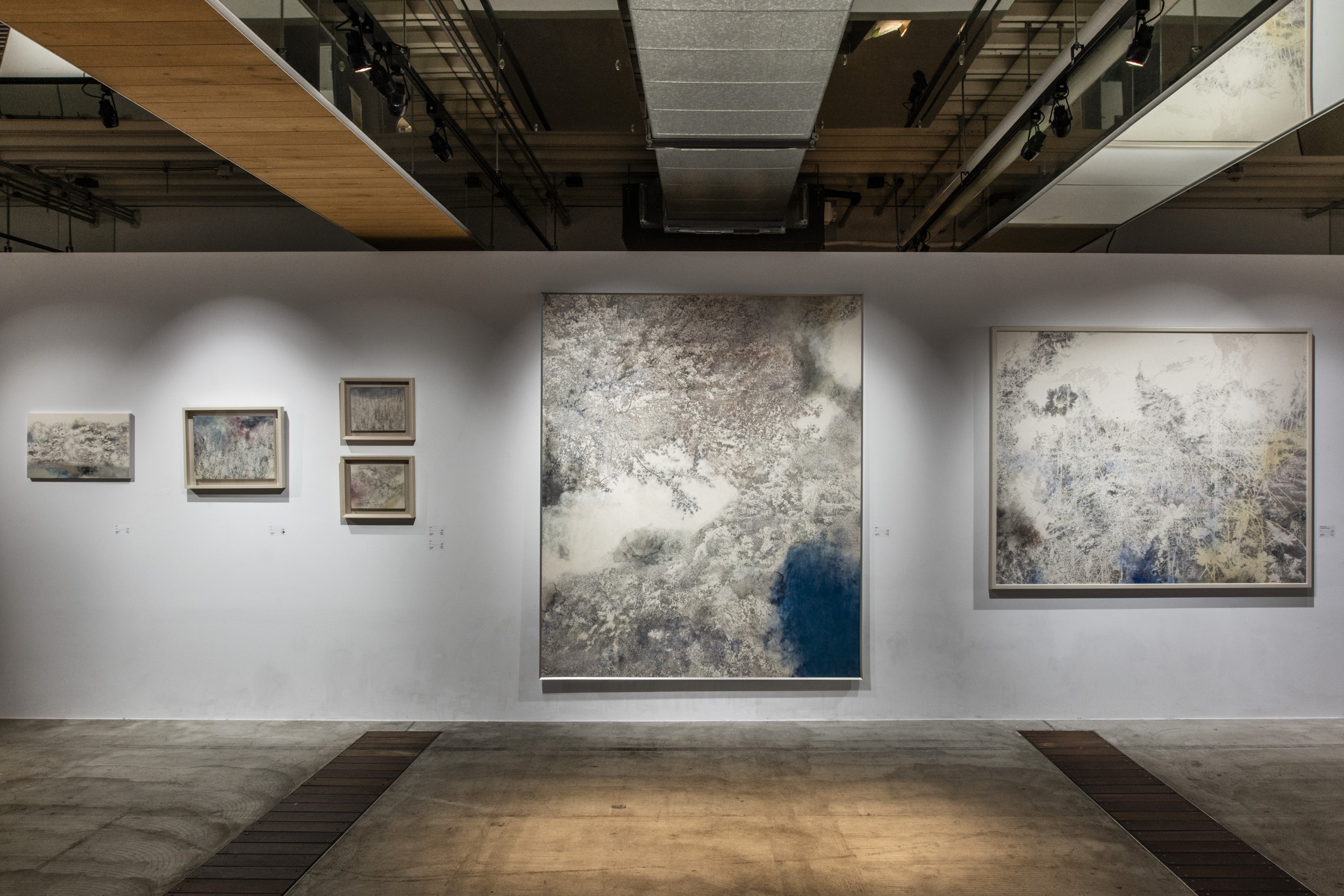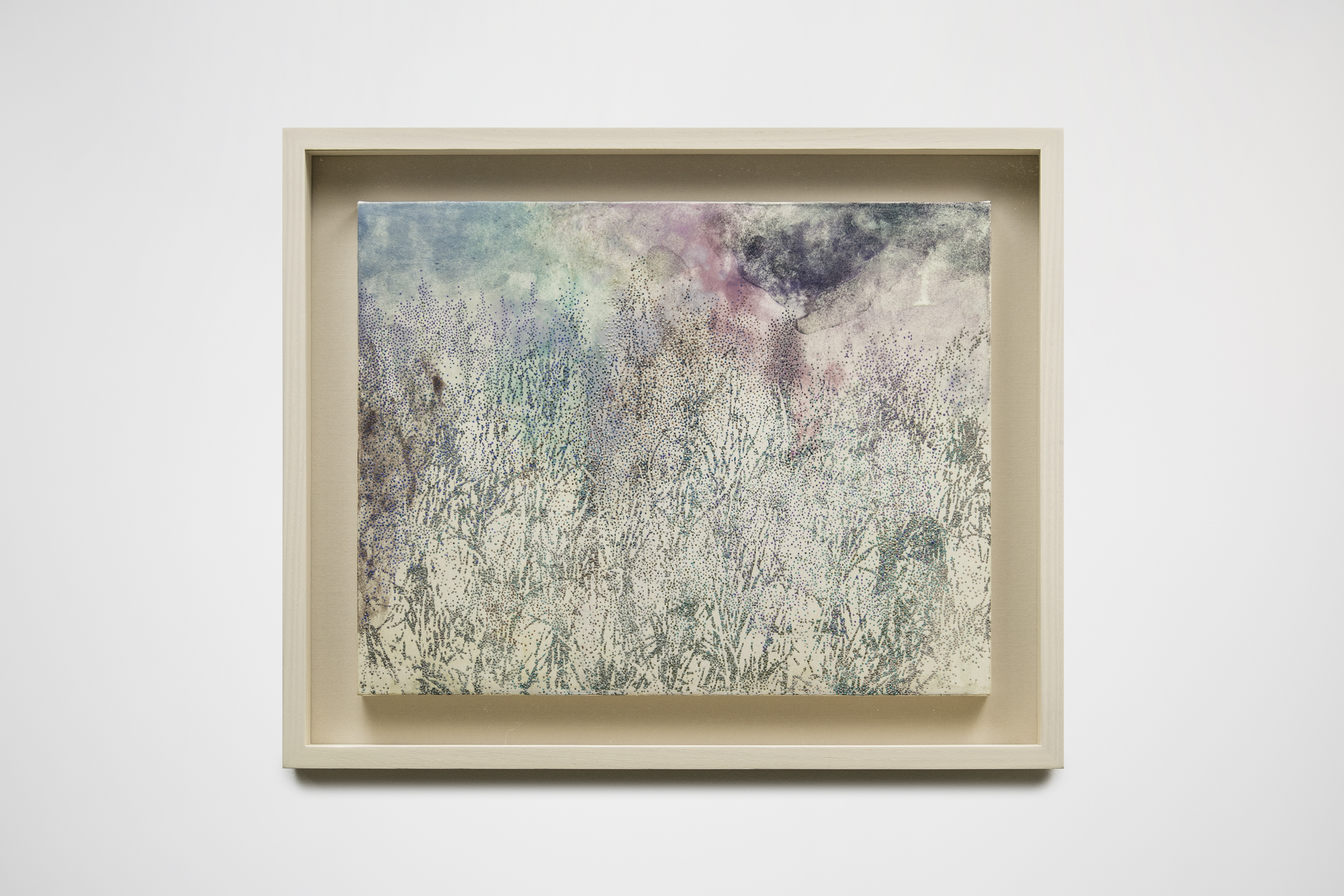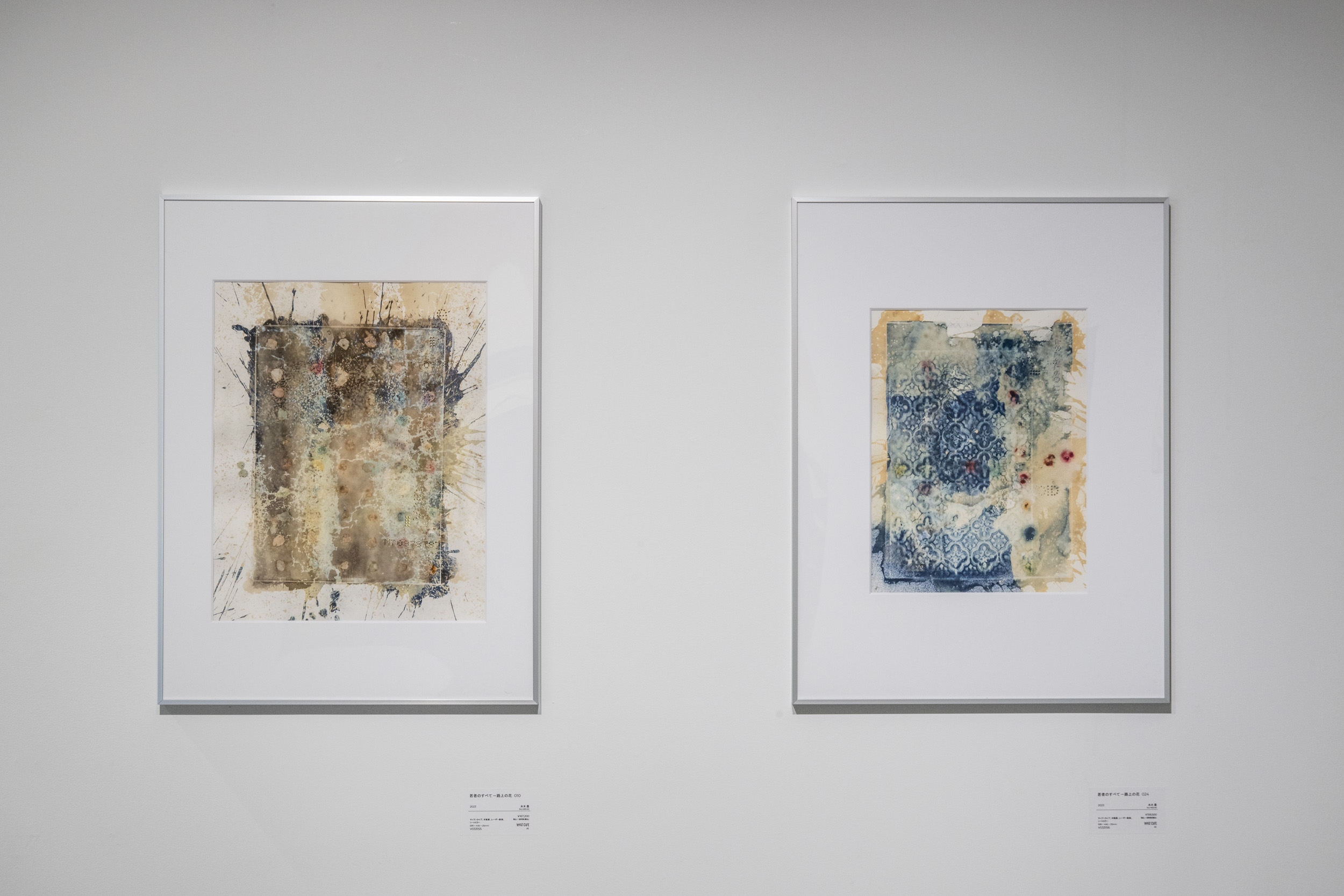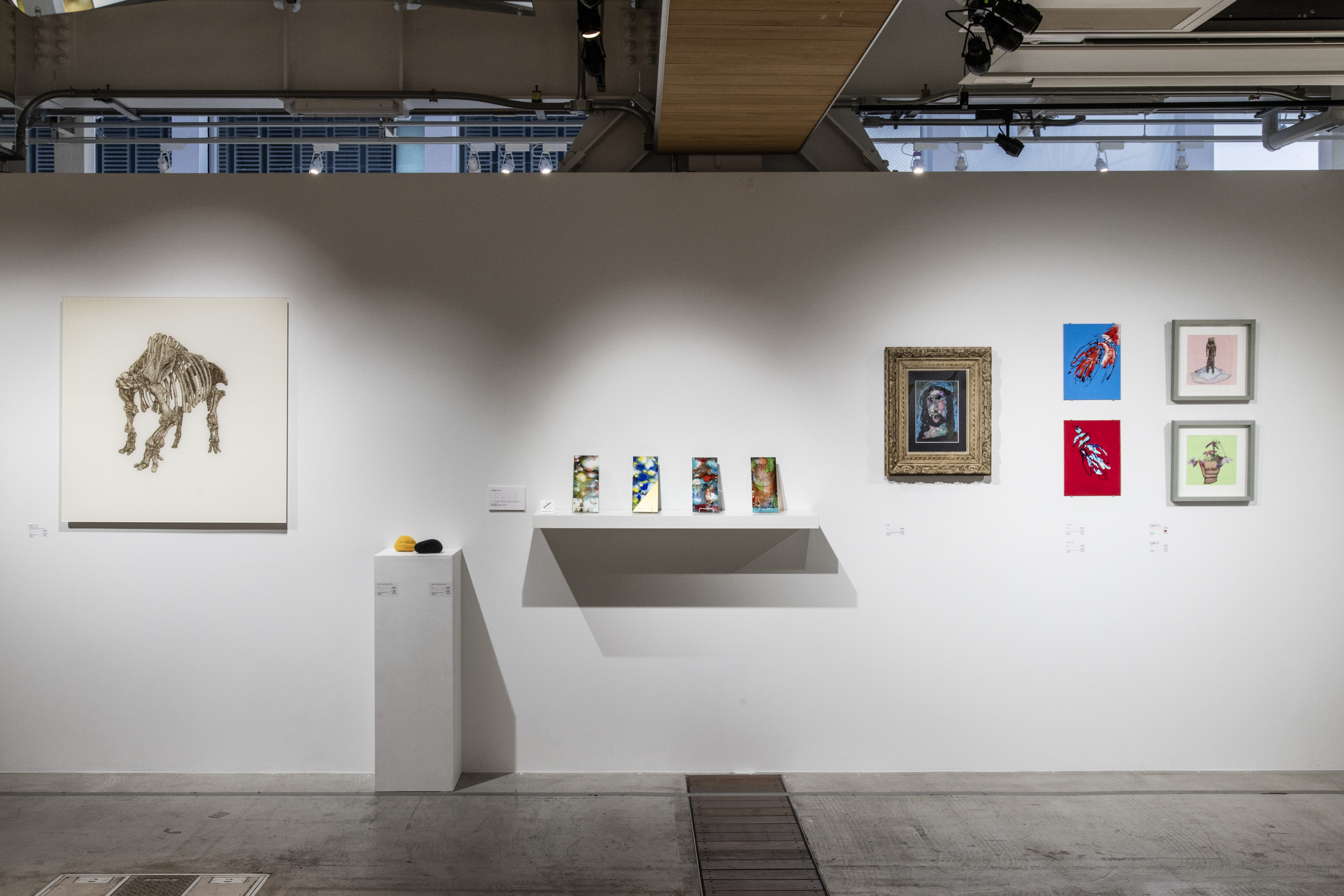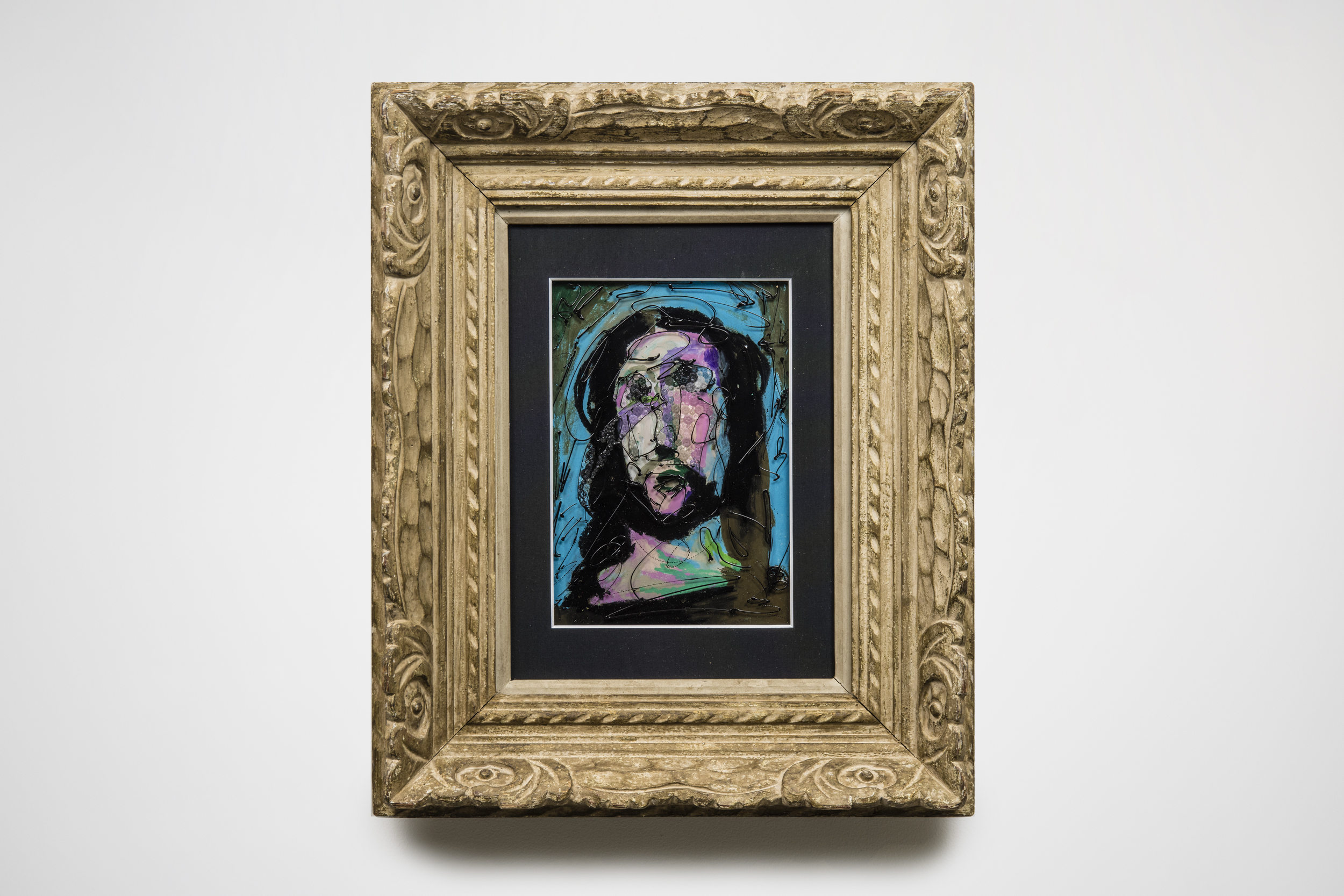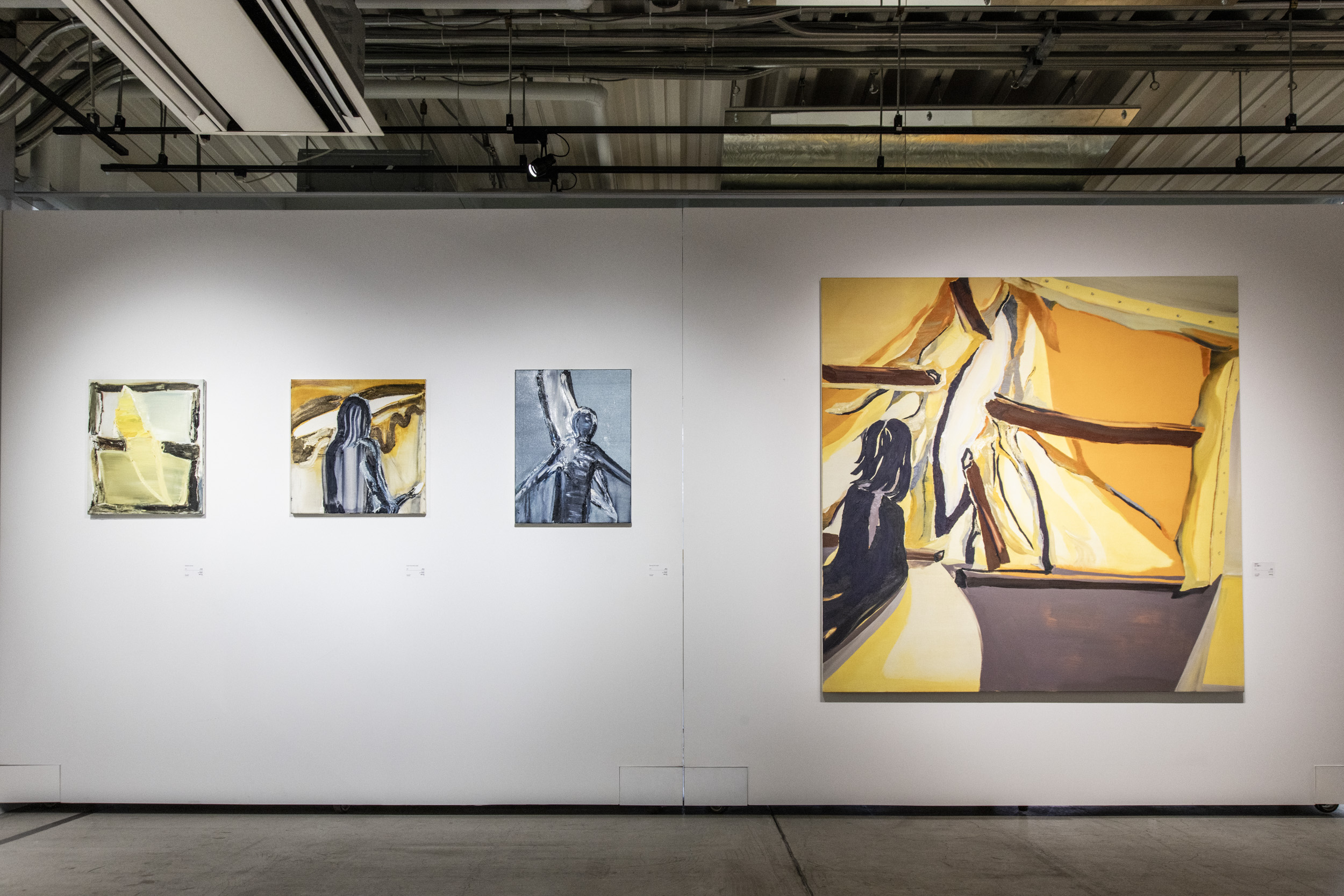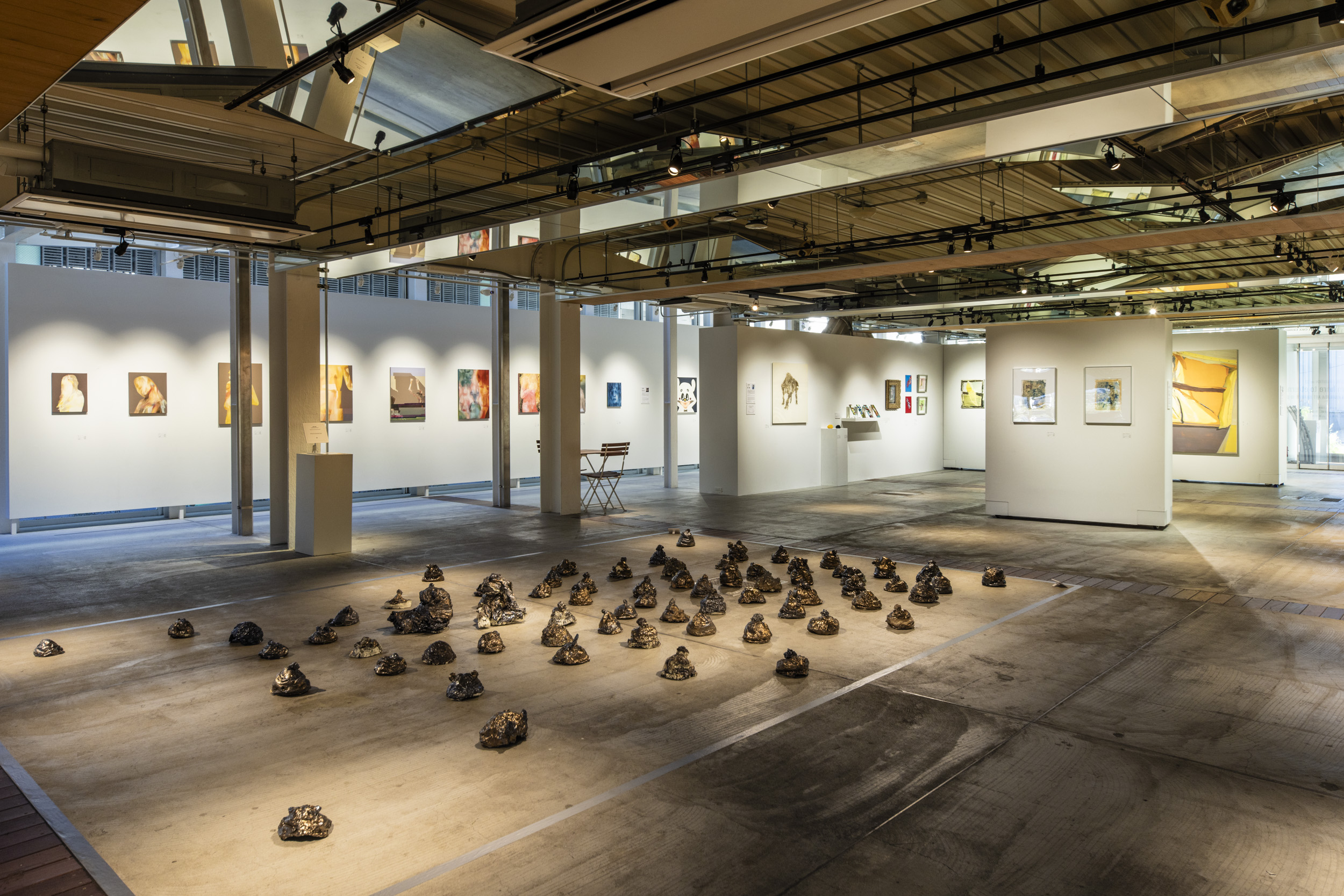展示レビュー
WHAT CAFE EXHIBITION vol.33
『From here to eternity』 展示レビュー
『From here to eternity』Review
『From here to eternity』Review
『From here to eternity』Review
2024/01/16 | レビュアー:吉田山 レビュアー:Yoshida Yamar レビュアー:Yoshida Yamar レビュアー:Yoshida Yamar
天王洲のアートギャラリー&カフェ「WHAT CAFE」で開催されていたWHAT CAFE EXHIBITION vol.33 『From here to eternity』の振り返りの記事である。<br /> <br /> この展覧会の内容としてはTERRADA ART AWARD(以下、アウォードと記載)の第1回目である2014での受賞者アーティストにフォーカスを当てた振り返りの企画となり、展覧会タイトルであるFrom here to eternityは1950年代のアメリカの小説のタイトルであり、この小説の日本語訳では『地上より永遠に』となっている。出展作家は、賀門利誓、久保田沙耶、黒田恭章、興梠優護、小谷里奈、榊貴美、須永有、財田翔悟、水木塁、山本雄教(敬称略・五十音順)。
This article looks back at WHAT CAFE EXHIBITION vol.33: “From here to eternity,” which was held at WHAT CAFE, an art gallery and café in Tennozu.<br /> <br /> This retrospective exhibition focused on recipients of the inaugural TERRADA ART AWARD held in 2014. The title, From here to eternity, is taken from an American novel of the 1950s, whose title was translated into Japanese as Chijō yori eien ni (literally “from earth to eternity”). The exhibition included works by Toshichika Kamon, Saya Kubota, Yasuaki Kuroda, Yugo Kohrogi, Rina Kotani, Kimi Sakaki, Aru Sunaga, Shogo Takarada, Rui Mizuki, and Yukyo Yamamoto (names given in Japanese syllabic order).
This article looks back at WHAT CAFE EXHIBITION vol.33: “From here to eternity,” which was held at WHAT CAFE, an art gallery and café in Tennozu.<br /> <br /> This retrospective exhibition focused on recipients of the inaugural TERRADA ART AWARD held in 2014. The title, From here to eternity, is taken from an American novel of the 1950s, whose title was translated into Japanese as Chijō yori eien ni (literally “from earth to eternity”). The exhibition included works by Toshichika Kamon, Saya Kubota, Yasuaki Kuroda, Yugo Kohrogi, Rina Kotani, Kimi Sakaki, Aru Sunaga, Shogo Takarada, Rui Mizuki, and Yukyo Yamamoto (names given in Japanese syllabic order).
This article looks back at WHAT CAFE EXHIBITION vol.33: “From here to eternity,” which was held at WHAT CAFE, an art gallery and café in Tennozu.<br /> <br /> This retrospective exhibition focused on recipients of the inaugural TERRADA ART AWARD held in 2014. The title, From here to eternity, is taken from an American novel of the 1950s, whose title was translated into Japanese as Chijō yori eien ni (literally “from earth to eternity”). The exhibition included works by Toshichika Kamon, Saya Kubota, Yasuaki Kuroda, Yugo Kohrogi, Rina Kotani, Kimi Sakaki, Aru Sunaga, Shogo Takarada, Rui Mizuki, and Yukyo Yamamoto (names given in Japanese syllabic order).
この展覧会は同時期に開催されている同じアウォードの4回目である『TERRADA ART AWARD 2023』の入選者展と連動しており、10年前2014年と2024年の10年間を想像させられる仕掛けとなっており、このアウォードの振り返りと継続の意志とも受け取れる。<br /> <br /> 作家それぞれの10年の変遷を展覧会で垣間見ることになる。筆者が展覧会をみた順番に記載していく。<br />
From here to eternity tied in with the exhibition of the finalists for the TERRADA ART AWARD 2023, the award’s fourth edition, which was held at the same time. This set-up provided a way to think about what has happened over the ten years from 2014 to 2024, and spoke of a desire to look back over the award’s history and to ensure its continuation.<br /> The exhibition provided a glimpse of each participating artist’s trajectory across the decade. Below, I write about the artists in the order in which I saw their work at the exhibition.<br />
From here to eternity tied in with the exhibition of the finalists for the TERRADA ART AWARD 2023, the award’s fourth edition, which was held at the same time. This set-up provided a way to think about what has happened over the ten years from 2014 to 2024, and spoke of a desire to look back over the award’s history and to ensure its continuation.<br /> The exhibition provided a glimpse of each participating artist’s trajectory across the decade. Below, I write about the artists in the order in which I saw their work at the exhibition.<br />
From here to eternity tied in with the exhibition of the finalists for the TERRADA ART AWARD 2023, the award’s fourth edition, which was held at the same time. This set-up provided a way to think about what has happened over the ten years from 2014 to 2024, and spoke of a desire to look back over the award’s history and to ensure its continuation.<br /> The exhibition provided a glimpse of each participating artist’s trajectory across the decade. Below, I write about the artists in the order in which I saw their work at the exhibition.<br />
榊貴美は1983年和歌山県生まれ。2012年東京造形大学の大学院を修了し、2014年にアウォードに入選。当時の入選作品であるペインティング作品も展示されている。
Kimi Sakaki was born in 1983 in Wakayama Prefecture. In 2012, she obtained her master’s degree at Tokyo Zokei University. In 2014, she received the TERRADA ART AWARD, and her winning painting was also shown in this exhibition.
Kimi Sakaki was born in 1983 in Wakayama Prefecture. In 2012, she obtained her master’s degree at Tokyo Zokei University. In 2014, she received the TERRADA ART AWARD, and her winning painting was also shown in this exhibition.
Kimi Sakaki was born in 1983 in Wakayama Prefecture. In 2012, she obtained her master’s degree at Tokyo Zokei University. In 2014, she received the TERRADA ART AWARD, and her winning painting was also shown in this exhibition.
2014年の当時から『子ども』が作品のテーマとなっており、その『子ども』を考察し続け描かれるミステリアスさが、子どもの目は描かないことや、油絵やアクリルを組み合わせて描かれる絵画制作の独自さと組み合わさっている。その後、2024年の新作まで一貫して『子ども』について10年描き続けるこのでの深化を見た。<br />
Since 2014, her works have been themed around children; the mysteriousness that comes from her close study of children combines with the fact that she doesn’t draw their eyes and her unique production process, which involves a combination of oil and acrylic paints. She has continued to paint children, right up to her 2024 work, and I could see how her treatment of the subject has deepened over the years.<br />
Since 2014, her works have been themed around children; the mysteriousness that comes from her close study of children combines with the fact that she doesn’t draw their eyes and her unique production process, which involves a combination of oil and acrylic paints. She has continued to paint children, right up to her 2024 work, and I could see how her treatment of the subject has deepened over the years.<br />
Since 2014, her works have been themed around children; the mysteriousness that comes from her close study of children combines with the fact that she doesn’t draw their eyes and her unique production process, which involves a combination of oil and acrylic paints. She has continued to paint children, right up to her 2024 work, and I could see how her treatment of the subject has deepened over the years.<br />
興梠優護は1982年熊本県生まれ。2009年に東京藝術大学大学院を修了し、人体モチーフを軸にした抽象的なペインティング作品を数シリーズ展開している。
Yugo Kohrogi was born in 1982 in Kumamoto Prefecture. In 2009, he obtained his master’s degree at Tokyo University of the Arts. He has exhibited several series of abstract paintings centered on the motif of the human body: like Sakaki, he pursues a variety of painting techniques while focusing on one theme.
Yugo Kohrogi was born in 1982 in Kumamoto Prefecture. In 2009, he obtained his master’s degree at Tokyo University of the Arts. He has exhibited several series of abstract paintings centered on the motif of the human body: like Sakaki, he pursues a variety of painting techniques while focusing on one theme.
Yugo Kohrogi was born in 1982 in Kumamoto Prefecture. In 2009, he obtained his master’s degree at Tokyo University of the Arts. He has exhibited several series of abstract paintings centered on the motif of the human body: like Sakaki, he pursues a variety of painting techniques while focusing on one theme.
こちらも榊と同じく、1つのテーマを中心に様々な絵画の方法を追求している。それぞれのシリーズの完成度から10年という時間の広がりと長さを想像することができる。
Judging by the level of accomplishment of each successive series, one really gets a sense of how long and expansive a decade is.<br />
Judging by the level of accomplishment of each successive series, one really gets a sense of how long and expansive a decade is.<br />
Judging by the level of accomplishment of each successive series, one really gets a sense of how long and expansive a decade is.<br />
黒田恭章は1986年生まれ。2012年武蔵野美術大学大学院修了し、糸から布を織るという行為に様々なテーマやコンセプトやプロセスを設定し編み込む作風が受賞から一貫している。
Yasuaki Kuroda was born in 1986. In 2012, he obtained his master’s degree at Musashino Art University. From his award ten years ago to his latest work, he has consistently incorporated various themes, concepts, and processes into his practice of weaving from thread.
Yasuaki Kuroda was born in 1986. In 2012, he obtained his master’s degree at Musashino Art University. From his award ten years ago to his latest work, he has consistently incorporated various themes, concepts, and processes into his practice of weaving from thread.
Yasuaki Kuroda was born in 1986. In 2012, he obtained his master’s degree at Musashino Art University. From his award ten years ago to his latest work, he has consistently incorporated various themes, concepts, and processes into his practice of weaving from thread.
入選作品は実物が展示してあり、草木染めを使用し糸なのでエイジングや退色があり、作家の意図でもあるという。このように制作後10年が経過した作品や経年変化をギャラリーでみることは稀かつ、糸や布のメディアとしての恒久性も実感できる。
His original prizewinning work was on display; because it used vegetable dyeing for the thread, it showed signs of aging and discoloration, which is apparently the artist’s intention. It is rare to see a work in a gallery like this, ten years after it was made, showing signs of the passage of time; it makes you see both the way the medium of thread and fabric endures, and also the way it changes.
His original prizewinning work was on display; because it used vegetable dyeing for the thread, it showed signs of aging and discoloration, which is apparently the artist’s intention. It is rare to see a work in a gallery like this, ten years after it was made, showing signs of the passage of time; it makes you see both the way the medium of thread and fabric endures, and also the way it changes.
His original prizewinning work was on display; because it used vegetable dyeing for the thread, it showed signs of aging and discoloration, which is apparently the artist’s intention. It is rare to see a work in a gallery like this, ten years after it was made, showing signs of the passage of time; it makes you see both the way the medium of thread and fabric endures, and also the way it changes.
賀門利誓は1988年大阪府生まれ。京都にて染色を専門に学び、日本の染色技法と染色科学から編み出された技巧によって、独自の写真作品を展開している。染色された細かい布をパネルに貼り付けていくという写真機のプロセスとは真逆ともいえる室内でのかなりの時間を要する作風で2014年に賞を取り、その後も同じ方法を突き詰めた作風と共にコンセプトを展開し、別の素材やメディアで展開する長尺の映像作品や陶器の作品シリーズが増え、10年の中でドラスティックな変化が起きていることを鑑賞できる。
Toshichika Kamon was born in Osaka Prefecture in 1988. He studied in Kyoto, specializing in dyeing. Kamon creates unique photographic works with an approach devised using Japanese dyeing science and techniques. He won the award in 2014 with a work made by sticking fine dyed fabric to the display panel: an indoor, time-consuming method that is the polar opposite to the photographic process. He continued to develop this concept thereafter, pushing his method further, and worked with different materials and media, becoming more prolific in long-form video and ceramics series. The exhibition revealed the drastic changes that have occurred in his work over the decade.
Toshichika Kamon was born in Osaka Prefecture in 1988. He studied in Kyoto, specializing in dyeing. Kamon creates unique photographic works with an approach devised using Japanese dyeing science and techniques. He won the award in 2014 with a work made by sticking fine dyed fabric to the display panel: an indoor, time-consuming method that is the polar opposite to the photographic process. He continued to develop this concept thereafter, pushing his method further, and worked with different materials and media, becoming more prolific in long-form video and ceramics series. The exhibition revealed the drastic changes that have occurred in his work over the decade.
Toshichika Kamon was born in Osaka Prefecture in 1988. He studied in Kyoto, specializing in dyeing. Kamon creates unique photographic works with an approach devised using Japanese dyeing science and techniques. He won the award in 2014 with a work made by sticking fine dyed fabric to the display panel: an indoor, time-consuming method that is the polar opposite to the photographic process. He continued to develop this concept thereafter, pushing his method further, and worked with different materials and media, becoming more prolific in long-form video and ceramics series. The exhibition revealed the drastic changes that have occurred in his work over the decade.
山本雄教は1988年京都府生まれ。2010年成安造形大学卒業、2013年京都造形芸術大学大学院修了。1円玉と和紙を使用して制作された当時の受賞作品が飾られている、基本的には1円玉という日本通貨の最小単位を素材として用いて、まさにミニマムアートと言える作品を展開しており、その方法は継続して今も制作されている。海外での展示の際はその国の硬貨を使用した作品も展示されていた。
Yukyo Yamamoto was born in 1988 in Kyoto Prefecture. He graduated from Seian University of Art and Design in 2010, and completed his master’s degree at Kyoto University of the Arts in 2013. The exhibition featured his prizewinning work, which was made from traditional washi paper and one-yen coins. He makes works that are best described as minimalist, using one-yen coins—the smallest denomination of Japanese currency—as his main material, and has continued with this method up to the present day. He has also exhibited works abroad, and this exhibition included works made using the coins of those countries.
Yukyo Yamamoto was born in 1988 in Kyoto Prefecture. He graduated from Seian University of Art and Design in 2010, and completed his master’s degree at Kyoto University of the Arts in 2013. The exhibition featured his prizewinning work, which was made from traditional washi paper and one-yen coins. He makes works that are best described as minimalist, using one-yen coins—the smallest denomination of Japanese currency—as his main material, and has continued with this method up to the present day. He has also exhibited works abroad, and this exhibition included works made using the coins of those countries.
Yukyo Yamamoto was born in 1988 in Kyoto Prefecture. He graduated from Seian University of Art and Design in 2010, and completed his master’s degree at Kyoto University of the Arts in 2013. The exhibition featured his prizewinning work, which was made from traditional washi paper and one-yen coins. He makes works that are best described as minimalist, using one-yen coins—the smallest denomination of Japanese currency—as his main material, and has continued with this method up to the present day. He has also exhibited works abroad, and this exhibition included works made using the coins of those countries.
財田翔悟は1986年神奈川県生まれ、2014年東北芸術工科大学大学院修了、徹底的に黒色の表現を追求する姿勢と近しい人物、おそらく家族を描くスタイルが10年間で追求されていることを鑑賞できる、黒い人物画なので少しダークな質感ではあるが近年では猫の平面作品や立体物も制作されているようで、10年の流れを感じる展示物だった。
Shogo Takarada was born in 1986 in Kanagawa Prefecture. In 2014, he completed his master’s degree at Tohoku University of Art and Design. Through his works, one can see how he has really committed to working with the color black, as well as his manner of depicting people close to him (probably his family). Their use of black lends his portraits a slightly dark air, but in recent years, he appears to have also made works—both paintings and sculptures—of cats. His exhibited works made one feel the passage of the years.
Shogo Takarada was born in 1986 in Kanagawa Prefecture. In 2014, he completed his master’s degree at Tohoku University of Art and Design. Through his works, one can see how he has really committed to working with the color black, as well as his manner of depicting people close to him (probably his family). Their use of black lends his portraits a slightly dark air, but in recent years, he appears to have also made works—both paintings and sculptures—of cats. His exhibited works made one feel the passage of the years.
Shogo Takarada was born in 1986 in Kanagawa Prefecture. In 2014, he completed his master’s degree at Tohoku University of Art and Design. Through his works, one can see how he has really committed to working with the color black, as well as his manner of depicting people close to him (probably his family). Their use of black lends his portraits a slightly dark air, but in recent years, he appears to have also made works—both paintings and sculptures—of cats. His exhibited works made one feel the passage of the years.
小谷里奈は1984年東京都生まれ。2012年多摩美術大学大学院修了し、2014年から一貫して風景画を手がける。受賞作品も展示してあり、風景や植物を画面の中で再構成しシルエット以外の部分を着色した独自の光の描き方を展開している。近作でもその画法は継続し、大きな作品1枚の制作に1年はかかるというその鍛錬を垣間見ることができる。
Rina Kotani was born in 1984 in Tokyo. In 2012, she completed her master’s degree at Tama Art University. Since 2014, she has consistently painted landscapes. Her prizewinning work was shown in the exhibition. She has a unique way of painting light, reconstructing a landscape and plants within the image and coloring everything but the silhouettes. She has continued this approach recently, and her discipline—it takes her a year to produce a single major work—was on evidence.
Rina Kotani was born in 1984 in Tokyo. In 2012, she completed her master’s degree at Tama Art University. Since 2014, she has consistently painted landscapes. Her prizewinning work was shown in the exhibition. She has a unique way of painting light, reconstructing a landscape and plants within the image and coloring everything but the silhouettes. She has continued this approach recently, and her discipline—it takes her a year to produce a single major work—was on evidence.
Rina Kotani was born in 1984 in Tokyo. In 2012, she completed her master’s degree at Tama Art University. Since 2014, she has consistently painted landscapes. Her prizewinning work was shown in the exhibition. She has a unique way of painting light, reconstructing a landscape and plants within the image and coloring everything but the silhouettes. She has continued this approach recently, and her discipline—it takes her a year to produce a single major work—was on evidence.
水木塁は1983年生まれ。京都市立芸術大学卒業、同大学博士号取得。この展示の中では異質な展示であり、近作のコロナ禍でニュースを騒がせた新宿の若者文化を写しとるシリーズのみの展開によって過去を振り返ることへの興味がないことを表明している。作家自身のストリート文化の考察や、ティーンエイジャーにとっては10年は長すぎることのリアリティの無さすらも想像し、このシリーズのコンセプトのみの展開となったのかもしれない。<br /> <br />
Rui Mizuki was born in 1983. He studied at Kyoto City University of Arts, going on to obtain a doctorate from the university. His works differed from the rest of the exhibition: he contributed only a series that captures the Shinjuku youth culture that made headlines during the pandemic, thus making clear, in a meta way, that he had no interest in the exhibition’s theme of “looking back on the past.” It may be that the artist decided to contribute only this series following his own studies of street culture, and after considering that, to a teenager, ten years is so long as to even seem unreal.
Rui Mizuki was born in 1983. He studied at Kyoto City University of Arts, going on to obtain a doctorate from the university. His works differed from the rest of the exhibition: he contributed only a series that captures the Shinjuku youth culture that made headlines during the pandemic, thus making clear, in a meta way, that he had no interest in the exhibition’s theme of “looking back on the past.” It may be that the artist decided to contribute only this series following his own studies of street culture, and after considering that, to a teenager, ten years is so long as to even seem unreal.
Rui Mizuki was born in 1983. He studied at Kyoto City University of Arts, going on to obtain a doctorate from the university. His works differed from the rest of the exhibition: he contributed only a series that captures the Shinjuku youth culture that made headlines during the pandemic, thus making clear, in a meta way, that he had no interest in the exhibition’s theme of “looking back on the past.” It may be that the artist decided to contribute only this series following his own studies of street culture, and after considering that, to a teenager, ten years is so long as to even seem unreal.
久保田沙耶は1987年茨城生まれ。東京藝術大学大学院修了後、同博士号取得。瀬戸内国際芸術祭の出展作品「漂流郵便局」で広く知られる作家。2014年の入選作品は組作品の片側のみ展示されており、紙に線香で焼きを入れることで動物の骨格を描いている平面作品である。その後もこの10年の中で様々な表現方法に取り組んでいたことがわかる多様な作品が飾られていた。例えば拾ってきた石に起毛を施した彫刻作品等。
Saya Kubota was born in 1987 in Ibaraki. She obtained her master’s degree and doctorate from Tokyo University of the Arts. Kubota became widely known through her work Missing Post Office, an installation created for the Setouchi Triennale. Her winning work from 2014 is a composite piece of which only a part was shown at the exhibition: she creates an image of an animal’s skeleton by burning paper with an incense stick.
Saya Kubota was born in 1987 in Ibaraki. She obtained her master’s degree and doctorate from Tokyo University of the Arts. Kubota became widely known through her work Missing Post Office, an installation created for the Setouchi Triennale. Her winning work from 2014 is a composite piece of which only a part was shown at the exhibition: she creates an image of an animal’s skeleton by burning paper with an incense stick.
Saya Kubota was born in 1987 in Ibaraki. She obtained her master’s degree and doctorate from Tokyo University of the Arts. Kubota became widely known through her work Missing Post Office, an installation created for the Setouchi Triennale. Her winning work from 2014 is a composite piece of which only a part was shown at the exhibition: she creates an image of an animal’s skeleton by burning paper with an incense stick.
アウトプットは多様だが、この10年間の作品に一貫しているのは、脱作家性をテーマとした作品作りであることが、10年間の作品が並ぶことで見えてくる。
A variety of other works were also on display, attesting to the range of creative methods she has tackled over the past ten years: for example, a sculptural project consisting of stones she collected and to which she added napped fabric. Her output may be varied, but one thing that has remained consistent in her works across the decade—and which becomes apparent when you see them together—is an approach that values “chance encounters” and thematizes the removal of authorial control.<br />
A variety of other works were also on display, attesting to the range of creative methods she has tackled over the past ten years: for example, a sculptural project consisting of stones she collected and to which she added napped fabric. Her output may be varied, but one thing that has remained consistent in her works across the decade—and which becomes apparent when you see them together—is an approach that values “chance encounters” and thematizes the removal of authorial control.<br />
A variety of other works were also on display, attesting to the range of creative methods she has tackled over the past ten years: for example, a sculptural project consisting of stones she collected and to which she added napped fabric. Her output may be varied, but one thing that has remained consistent in her works across the decade—and which becomes apparent when you see them together—is an approach that values “chance encounters” and thematizes the removal of authorial control.<br />
須永有は1989年群馬県生まれ。2014年東京芸術大学卒業、 2017年東京芸術大学大学院修士修了のペインター。当時の受賞作品も展示されており、力強く描かれたキャンバスの切れ込みと作家自身の後ろ姿を描いた平面作品のそのワイルドさを10年越えた今でも体感することができる。近作でも一貫した強い描き方と影を描くことを鑑賞することができる。
Aru Sunaga was born in 1989 in Gunma Prefecture. She is a painter who studied at Tokyo University of the Arts, graduating in 2014 and obtaining her master’s degree in 2017. Her prizewinning work of 2014 was shown at the exhibition; even ten years on, the wildness of this painting, with its powerful cuts in the canvas and depiction of the artist from behind, remains palpable. Her strong style and portrayal of shadow run through her more recent works too.
Aru Sunaga was born in 1989 in Gunma Prefecture. She is a painter who studied at Tokyo University of the Arts, graduating in 2014 and obtaining her master’s degree in 2017. Her prizewinning work of 2014 was shown at the exhibition; even ten years on, the wildness of this painting, with its powerful cuts in the canvas and depiction of the artist from behind, remains palpable. Her strong style and portrayal of shadow run through her more recent works too.
Aru Sunaga was born in 1989 in Gunma Prefecture. She is a painter who studied at Tokyo University of the Arts, graduating in 2014 and obtaining her master’s degree in 2017. Her prizewinning work of 2014 was shown at the exhibition; even ten years on, the wildness of this painting, with its powerful cuts in the canvas and depiction of the artist from behind, remains palpable. Her strong style and portrayal of shadow run through her more recent works too.
様々なアーティストの10年間を見た。補足しておくと、このように平面作品が多いのは、このアウォードの第1回目2014年の応募条件に『絵画、写真、版画などの平面作品で、寺田倉庫にて保管が可能な作品』が書かれていることに由来しているようだ。<br /> <br /> なお、本展と連動して別会場で開催していた「TERRADA ART AWARD 2023 ファイナリスト展」は、全て映像作品やインスタレーションと呼ばれる一つの部屋や空間全てにその作家の世界観を反映させる方法を用いている。インスタレーションは1970年代にはアートシーンに登場し普及しており、2014年にはもちろん存在しているので、アーティストによってはインスタレーションや映像作品の作品を展開しているドラスティックさもこの展示の面白さと言える。<br /> <br /> このように10年前に同じアウォードで入選し10年経過したアーティストの変遷や作品自体を知る機会はとても稀な機会だと思う。
And so it was that I saw all these artists’ work from across a decade. It’s worth noting that the prevalence of paintings and the like seems to be due to the fact that one of the rules for the inaugural award in 2014 was that the artist had to submit “a painting, photograph, print or other two-dimensional work that can be stored at Warehouse TERRADA.”<br /> <br /> I’ll also add that at the TERRADA ART AWARD 2023 Finalist Exhibition, which was held in parallel at a different venue, all the works involved video or installations—methods whereby the artist projects their vision across an entire room or space. Installations appeared on the art scene in the 1970s and spread from there; of course, they existed in 2014. So one of the interesting things about this exhibition was the drastic contrast it struck by exhibiting these artists’ installations and video works.<br /> <br /> It is rare to get this kind of opportunity to discover the developments and works of artists across the ten years since they won the same award.<br />
And so it was that I saw all these artists’ work from across a decade. It’s worth noting that the prevalence of paintings and the like seems to be due to the fact that one of the rules for the inaugural award in 2014 was that the artist had to submit “a painting, photograph, print or other two-dimensional work that can be stored at Warehouse TERRADA.”<br /> <br /> I’ll also add that at the TERRADA ART AWARD 2023 Finalist Exhibition, which was held in parallel at a different venue, all the works involved video or installations—methods whereby the artist projects their vision across an entire room or space. Installations appeared on the art scene in the 1970s and spread from there; of course, they existed in 2014. So one of the interesting things about this exhibition was the drastic contrast it struck by exhibiting these artists’ installations and video works.<br /> <br /> It is rare to get this kind of opportunity to discover the developments and works of artists across the ten years since they won the same award.<br />
And so it was that I saw all these artists’ work from across a decade. It’s worth noting that the prevalence of paintings and the like seems to be due to the fact that one of the rules for the inaugural award in 2014 was that the artist had to submit “a painting, photograph, print or other two-dimensional work that can be stored at Warehouse TERRADA.”<br /> <br /> I’ll also add that at the TERRADA ART AWARD 2023 Finalist Exhibition, which was held in parallel at a different venue, all the works involved video or installations—methods whereby the artist projects their vision across an entire room or space. Installations appeared on the art scene in the 1970s and spread from there; of course, they existed in 2014. So one of the interesting things about this exhibition was the drastic contrast it struck by exhibiting these artists’ installations and video works.<br /> <br /> It is rare to get this kind of opportunity to discover the developments and works of artists across the ten years since they won the same award.<br />

